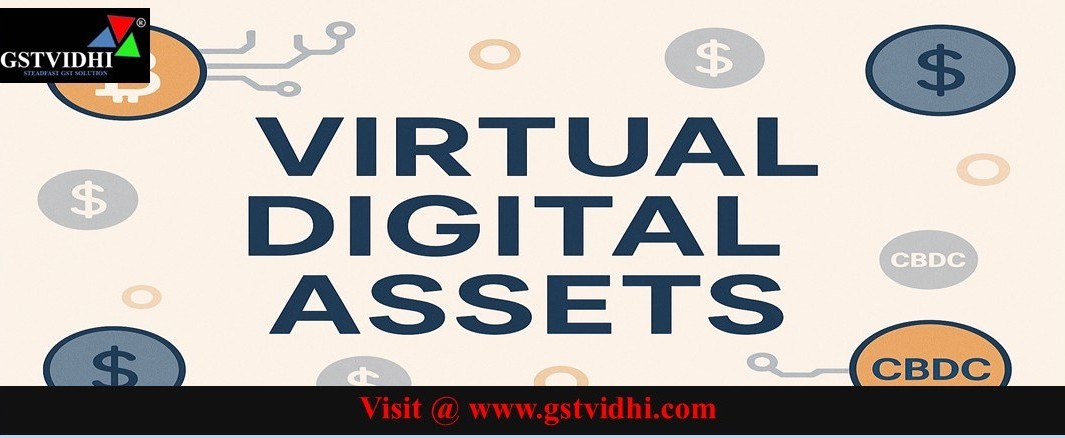
Virtual Digital Assets — Types of Virtual Digital Assets (Cryptocurrencies
/ Non-Fungible Tokens (NFTs) / Stablecoins / Central Bank Digital Currency
(CBDC))
In today’s digital age,
many new forms of assets have emerged that exist only on the internet. These
are known as Virtual Digital Assets (VDAs). The term became popular in
India after the Finance Act, 2022, which introduced this concept mainly
for taxation purposes. However, most people still find it confusing. This
article will help you understand the basics of Virtual Digital Assets in simple
language.
What Are
Virtual Digital Assets?
Virtual Digital Assets
are special types of assets that are stored and used digitally. They are not
physical objects like gold, cash, or property. Instead, they exist only on
digital platforms. These assets are based on advanced technologies like blockchain
and are used for online transactions, investments, or proof of ownership.
The main purpose behind
defining VDAs in the Finance Act, 2022, was to bring cryptocurrencies and NFTs
(Non-Fungible Tokens) under the tax system. However, this definition does not
include digital gold, digital currencies issued by central banks (like CBDCs),
or other traditional digital assets. In simple words, Virtual Digital Assets
mainly refer to modern digital assets like cryptocurrencies, NFTs, and DeFi
tokens.
Types of
Virtual Digital Assets
1. Cryptocurrencies
Cryptocurrencies are a
type of virtual digital asset that acts like digital money. Unlike regular
money issued by governments, cryptocurrencies are created using computer codes
and secured by a technology called cryptography. This makes them very
hard to fake or misuse.
The special thing about
cryptocurrencies is that they work on a blockchain system, which is a
type of online ledger that records every transaction openly and securely.
Popular examples of cryptocurrencies include Bitcoin, Ethereum, and Litecoin.
These digital coins are used for online payments, investments, or trading on
crypto exchanges.
However, it is important
to understand that cryptocurrencies are very volatile, meaning their prices can
rise or fall quickly. Because of this, they are often considered risky
investments.
2. Non-Fungible
Tokens (NFTs)
NFTs, or Non-Fungible
Tokens, are another popular form of virtual digital asset. The word
"Non-Fungible" means that each token is unique and cannot be
exchanged on a one-to-one basis like regular money.
NFTs act like digital
certificates of ownership. They are mostly used by artists, musicians, and
creators to sell their digital work, such as art, music, videos, or even
tweets. The blockchain keeps a record of who owns the NFT, making it impossible
to duplicate or fake.
Some common features of
NFTs are that they are unique, cannot be replaced, and can even be combined
with other NFTs to create something new. They also have many uses, such as
proving identity, tracking products in a supply chain, or selling collectibles online.
Famous examples of NFTs
include Cryptopunks and “Everydays: The First 5000 Days” by Beeple,
which was sold for millions of dollars.
3. Stablecoins
Stablecoins are a type of
cryptocurrency, but with a twist. Unlike regular cryptocurrencies like Bitcoin,
which often have huge price swings, Stablecoins are linked to real-world assets
like the US Dollar or gold.
This link helps keep
their price stable. For example, if a Stablecoin is pegged to the US Dollar,
its value will always remain close to $1. This makes Stablecoins very useful
for online payments, currency exchanges, or saving digital money without the fear
of price changes.
Some of the most common
Stablecoins are Tether (USDT) and USD Coin (USDC). These coins
provide the benefits of cryptocurrency with more price stability, making them
attractive for regular transactions.
4. Central
Bank Digital Currency (CBDC)
Central Bank Digital
Currency, commonly known as CBDC, is a digital version of money issued
by a country’s central bank. It works like the traditional currency we use but
in a digital form. Unlike cryptocurrencies, CBDCs are fully backed and
controlled by the government or central bank, which means they carry legal
recognition.
The idea behind CBDCs is
to provide people with a safe and efficient digital payment option that is
regulated and trusted. Countries around the world, including India, are
exploring or launching their versions of CBDCs.
CBDCs are expected to
make online transactions faster, cheaper, and more secure while giving
governments better control over monetary policies.
Why Are
Virtual Digital Assets Important?
Virtual Digital Assets
are changing the way people invest, trade, and even own things. They have
created new markets for digital art, online payments, and decentralised
finance. However, because of their fast growth and the risks involved,
governments across the world are keeping a close watch on them, especially for
tax and legal purposes.
For individuals and
businesses, understanding VDAs is important to stay updated with modern
financial trends. Whether you want to invest in cryptocurrencies, create NFTs,
or simply know about new digital payment systems, learning about VDAs can open
new opportunities.
Conclusion
Virtual Digital Assets
are more than just a trend — they are becoming a part of everyday financial
life. From digital currencies to unique art tokens, VDAs have brought exciting
changes in the world of finance and technology.
While they offer new
opportunities for trade, investment, and creativity, they also come with risks
like price fluctuations and regulatory uncertainties. Therefore, it is always
wise to stay informed and cautious when dealing with any form of Virtual Digital
Asset.
Disclaimer: All the Information is based on the notification, circular advisory and order issued by the Govt. authority and judgement delivered by the court or the authority information is strictly for educational purposes and on the basis of our best understanding of laws & not binding on anyone.
Click here